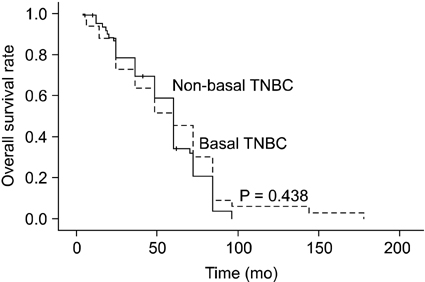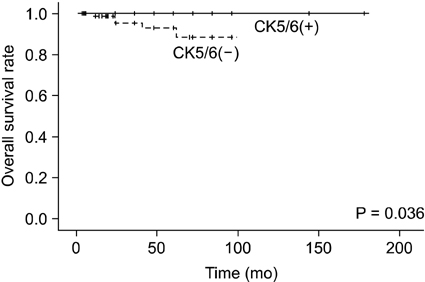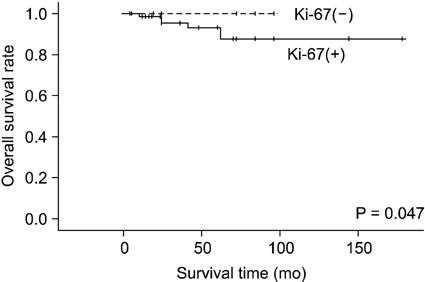J Korean Surg Soc.
2012 Oct;83(4):187-195. 10.4174/jkss.2012.83.4.187.
Outcome of triple-negative breast cancer in patients with or without markers regulating cell cycle and cell death
- Affiliations
-
- 1Department of Surgery, Kosin University Gospel Hospital, Busan, Korea. lovebreast@naver.com
- KMID: 2212302
- DOI: http://doi.org/10.4174/jkss.2012.83.4.187
Abstract
- PURPOSE
The genes p53 and B-cell lymphoma (bcl)-2 play an important role in regulating the mechanisms of apoptosis. In this paper, we retrospectively applied these factors to our series of triple negative breast cancer (TNBC) patients, in conjunction with an evaluation of the prognostic significance of these factors' influence on TNBC survival rate. Particular focus was placed on the role of bcl-2, p53, Ki-67.
METHODS
The study subjects, 94 women with TNBC, were a subset of patients operated at Kosin University Gospel Hospital from January 2000 to December 2005. Chi-squared tests were used for statistical analysis.
RESULTS
Positive staining for cytokeratin (CK)5/6 in 23 cases (24.5%), epidermal growth factor receptor in 15 cases (16.0%), bcl-2 in 26 cases (27.7%), p53 in 55 cases (58.5%) and Ki-67 in 74 cases (78.7%) was determined. Lymph node status, tumor size and expression of CK5/6 or Ki-67 were independent prognostic factors for patients with TNBC.
CONCLUSION
Markers regulating cell cycle and cell death such as p53 and bcl-2 cannot be used to classify TNBCs into two subtypes with differing disease-free survival. But because our study is small in size, more abundant patient data will be needed to evaluate the factors' predictive role in regulating cell cycle and cell death.
Keyword
MeSH Terms
Figure
Reference
-
1. Nakagawa M, Bando Y, Nagao T, Morimoto M, Takai C, Ohnishi T, et al. Expression of p53, Ki-67, E-cadherin, N-cadherin and TOP2A in triple-negative breast cancer. Anticancer Res. 2011. 31:2389–2393.2. Elnashar AT, Ali el-SM, Gaber A. The prognostic value of triple negative in stage II/III breast cancer. J Oncol Pharm Pract. 2012. 18:68–75.3. Yerushalmi R, Tyldesley S, Kennecke H, Speers C, Woods R, Knight B, et al. Tumor markers in metastatic breast cancer subtypes: frequency of elevation and correlation with outcome. Ann Oncol. 2012. 23:338–345.4. Montagna E, Bagnardi V, Rotmensz N, Viale G, Renne G, Cancello G, et al. Breast cancer subtypes and outcome after local and regional relapse. Ann Oncol. 2012. 23:324–331.5. Skarlos P, Christodoulou C, Kalogeras KT, Eleftheraki AG, Bobos M, Batistatou A, et al. Triple-negative phenotype is of adverse prognostic value in patients treated with dose-dense sequential adjuvant chemotherapy: a translational research analysis in the context of a Hellenic Cooperative Oncology Group (HeCOG) randomized phase III trial. Cancer Chemother Pharmacol. 2012. 69:533–546.6. Nishimura R, Osako T, Okumura Y, Tashima R, Toyozumi Y, Arima N. Changes in the ER, PgR, HER2, p53 and Ki-67 biological markers between primary and recurrent breast cancer: discordance rates and prognosis. World J Surg Oncol. 2011. 9:131.7. Kallel-Bayoudh I, Hassen HB, Khabir A, Boujelbene N, Daoud J, Frikha M, et al. Bcl-2 expression and triple negative profile in breast carcinoma. Med Oncol. 2011. 28:Suppl 1. S55–S61.8. Chae BJ, Bae JS, Lee A, Park WC, Seo YJ, Song BJ, et al. p53 as a specific prognostic factor in triple-negative breast cancer. Jpn J Clin Oncol. 2009. 39:217–224.9. Collins LC, Marotti JD, Gelber S, Cole K, Ruddy K, Kereakoglow S, et al. Pathologic features and molecular phenotype by patient age in a large cohort of young women with breast cancer. Breast Cancer Res Treat. 2012. 131:1061–1066.10. Tawfik K, Kimler BF, Davis MK, Fan F, Tawfik O. Prognostic significance of Bcl-2 in invasive mammary carcinomas: a comparative clinicopathologic study between "triple-negative" and non-"triple-negative" tumors. Hum Pathol. 2012. 43:23–30.11. Lee DS, Kim SH, Suh YJ, Kim S, Kim HK, Shim BY. Clinical implication of p53 overexpression in breast cancer patients younger than 50 years with a triple-negative subtype who undergo a modified radical mastectomy. Jpn J Clin Oncol. 2011. 41:854–866.12. Jiang Z, Jones R, Liu JC, Deng T, Robinson T, Chung PE, et al. RB1 and p53 at the crossroad of EMT and triple-negative breast cancer. Cell Cycle. 2011. 10:1563–1570.13. Lee DS, Kim SH, Kim S, Suh YJ, Kim HK, Shim BY. Prognostic significance of breast cancer subtype and p53 overexpression in patients with locally advanced or high-risk breast cancer treated using upfront modified radical mastectomy with or without post-mastectomy radiation therapy. Int J Clin Oncol. 2011. 09. 07. [Epub]. http://dx.doi.org/10.1007/s10147-011-0309-0.14. Biganzoli E, Coradini D, Ambrogi F, Garibaldi JM, Lisboa P, Soria D, et al. p53 status identifies two subgroups of triple-negative breast cancers with distinct biological features. Jpn J Clin Oncol. 2011. 41:172–179.15. Guarneri V, Barbieri E, Piacentini F, Giovannelli S, Ficarra G, Frassoldati A, et al. Predictive and prognostic role of p53 according to tumor phenotype in breast cancer patients treated with preoperative chemotherapy: a single-institution analysis. Int J Biol Markers. 2010. 25:104–111.16. Jung SY, Jeong J, Shin SH, Kwon Y, Kim EA, Ko KL, et al. Accumulation of p53 determined by immunohistochemistry as a prognostic marker in node negative breast cancer; analysis according to St Gallen consensus and intrinsic subtypes. J Surg Oncol. 2011. 103:207–211.17. Moran MS, Yang Q, Haffty BG. The Yale University experience of early-stage invasive lobular carcinoma (ILC) and invasive ductal carcinoma (IDC) treated with breast conservation treatment (BCT): analysis of clinical-pathologic features, long-term outcomes, and molecular expression of COX-2, Bcl-2, and p53 as a function of histology. Breast J. 2009. 15:571–578.18. Tawfik O, Davis K, Kimler BF, Davis MK, Hull S, Fan F, et al. Clinicopathological characteristics of triple-negative invasive mammary carcinomas in African-American versus Caucasian women. Ann Clin Lab Sci. 2010. 40:315–323.19. Broustas CG, Ross JS, Yang Q, Sheehan CE, Riggins R, Noone AM, et al. The proapoptotic molecule BLID interacts with Bcl-XL and its downregulation in breast cancer correlates with poor disease-free and overall survival. Clin Cancer Res. 2010. 16:2939–2948.20. Rhee J, Han SW, Oh DY, Kim JH, Im SA, Han W, et al. The clinicopathologic characteristics and prognostic significance of triple-negativity in node-negative breast cancer. BMC Cancer. 2008. 8:307.21. Nozoe T, Mori E, Kono M, Iguchi T, Maeda T, Matsukuma A, et al. Serum appearance of anti-p53 antibody in triple negative breast cancer. Breast Cancer. 2012. 19:11–15.22. Keam B, Im SA, Kim HJ, Oh DY, Kim JH, Lee SH, et al. Prognostic impact of clinicopathologic parameters in stage II/III breast cancer treated with neoadjuvant docetaxel and doxorubicin chemotherapy: paradoxical features of the triple negative breast cancer. BMC Cancer. 2007. 7:203.
- Full Text Links
- Actions
-
Cited
- CITED
-
- Close
- Share
- Similar articles
-
- Overexpression of Cell Cycle Progression Inhibitor Geminin is Associated with Tumor Stem-Like Phenotype of Triple-Negative Breast Cancer
- Quercetin induces apoptosis and cell cycle arrest in triple-negative breast cancer cells through modulation of Foxo3a activity
- In vivo validation of metastasis-regulating microRNA-766 in human triple-negative breast cancer cells
- Caveolin-1 Modulates Docetaxel-Induced Cell Death in Breast Cancer Cell Subtypes through Different Mechanisms
- Hydroxyzine Induces Cell Death in Triple-Negative Breast Cancer Cells via Mitochondrial Superoxide and Modulation of Jak2/STAT3 Signaling





